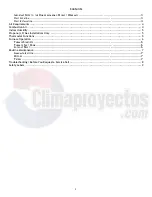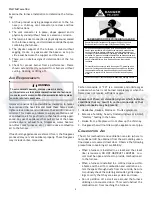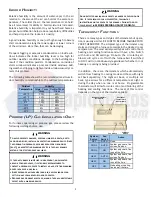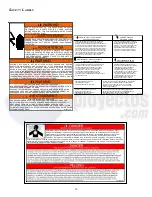
4
U
NIT
I
NSTALLATION
Examine the furnace installation to determine the follow-
ing:
1. All flue product carrying passages external to the fur-
nace (i.e. chimney, vent connector) are clear and free
of obstructions.
2. The vent connector is in place, slopes upward and is
physically sound without holes or excessive corrosion.
3. The return air duct connection is physically sound, sealed
to the furnace casing, and terminates outside the space
containing the furnace.
4. The physical support of the furnace is sound without
sagging, cracks, or gaps around the base so as to pro-
vide a seal between the support and the base.
5. There are no obvious signs of deterioration of the fur-
nace.
6. Check for proper burner flame performance. Flame
should extend directly outward from burners without
curling, floating, or lifting off.
A
IR
R
EQUIREMENTS
T
O
AVOID
PROPERTY
DAMAGE
,
PERSONAL
INJURY
OR
DEATH
,
SUFFICIENT
FRESH
AIR
FOR
PROPER
COMBUSTION
AND
VENTILATION
OF
FLUE
GASES
MUST
BE
SUPPLIED
.
M
OST
HOMES
REQUIRE
OUTSIDE
AIR
BE
SUPPLIED
INTO
THE
FURNACE
AREA
.
WARNING
Improved construction and additional insulation in homes
have reduced the heat loss and made these homes much
tighter around doors and windows so that air infiltration is
minimal. This creates a problem to supply ventilation and/
or combustion air for gas fired or other fuel burning appli-
ances. Any use of appliances that pull air out of the house
(clothes dryers, exhaust fans, fireplaces, water heaters,
non-direct vent furnaces, etc.) could reduce combustion
air to the furnace.
If fuel-burning appliances are starved for air, the flue gases
produced may not vent outdoors properly. These flue gases
may include carbon monoxide.
CARBON MONOXIDE POISONING HAZARD
B10259-216
Carbon monoxide producing devices (such as an automobile, space
heater, gas water heater, etc.) should not be operated in enclosed areas
such as unventilated garages, utility rooms or parking areas because of
the danger of carbon monoxide (CO) poisoning resulting from the exhaust
emissions. If a furnace or air handler is installed in an enclosed area such
as a garage, utility room or parking area and a carbon monoxide producing
device is operated therein, there must be adequate, direct outside
ventilation.
This ventilation is necessary to avoid the danger of CO poisoning which
can occur if a carbon monoxide producing device continues to operate in
the enclosed area. Carbon monoxide emissions can be (re)circulated
throughout the structure if the furnace or air handler is operating in any
mode.
CO can cause serious illness including permanent brain damage or death.
Special Warning for Installation of Furnaces or Air Handling Units in
Enclosed Areas such as Garages, Utility Rooms or Parking Areas
Carbon monoxide or “CO” is a colorless and odorless gas
produced when fuel is not burned completely or when the
flame does not receive sufficient oxygen.
Be aware of these air starvation signals which indicate
conditions that my result in carbon monoxide or that
carbon monoxide may be present:
1. Headaches, Nausea, Dizziness, Flu-like symptoms.
2. Excessive humidity, heavily frosted windows or a moist
“clammy” feeling in the home.
3. Smoke from a fireplace will not draw up the chimney.
4. Flue gases that will not draw up the appliance vent pipe.
C
OMBUSTION
A
IR
The air for combustion and ventilation can also (where lo-
cal codes permit) be obtained from the surrounding uncon-
fined space or louvered closet door. Observe the following
precautions concerning air availability:
• When a furnace is installed in a closet and the closet
door is louvered, DO NOT OBSTRUCT LOUVERS. Lou-
vers must be open and clear to provide combustion air
to the furnace.
• When a furnace is installed in a confined space within
a home and the air for combustion and ventilation en-
ters the space through ducts from the outside, be sure
to routinely check the entering and outlet, grilled open-
ings to verify that they are always clear and clean.
• Do not partition off a small area around the furnace
utilizing a non-louvered door. This could obstruct the
combustion air from reaching the furnace.






























